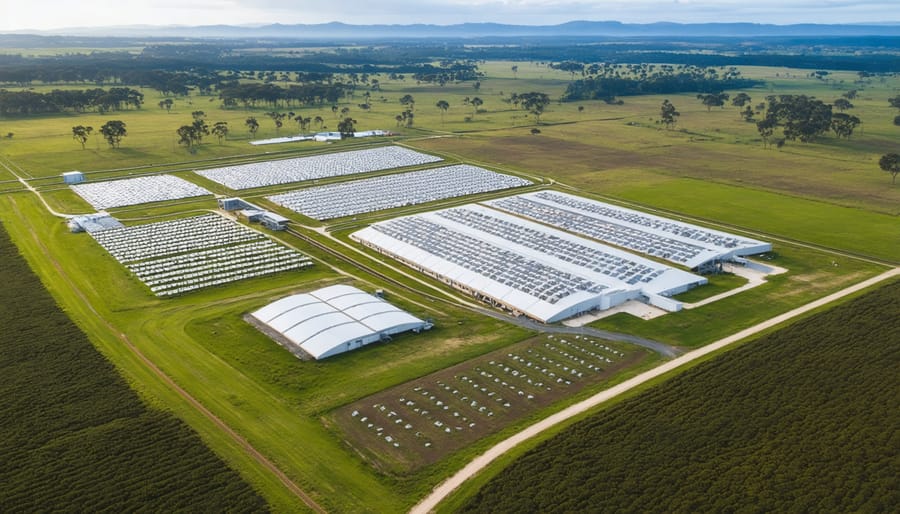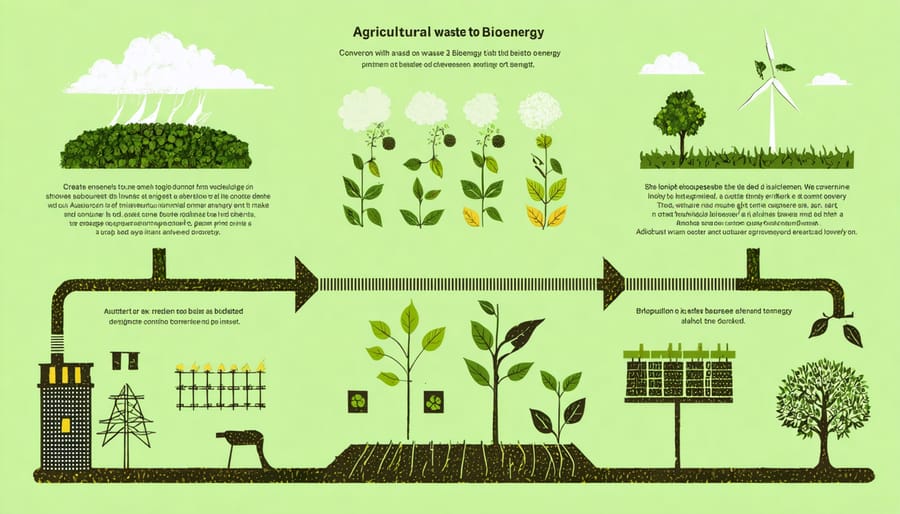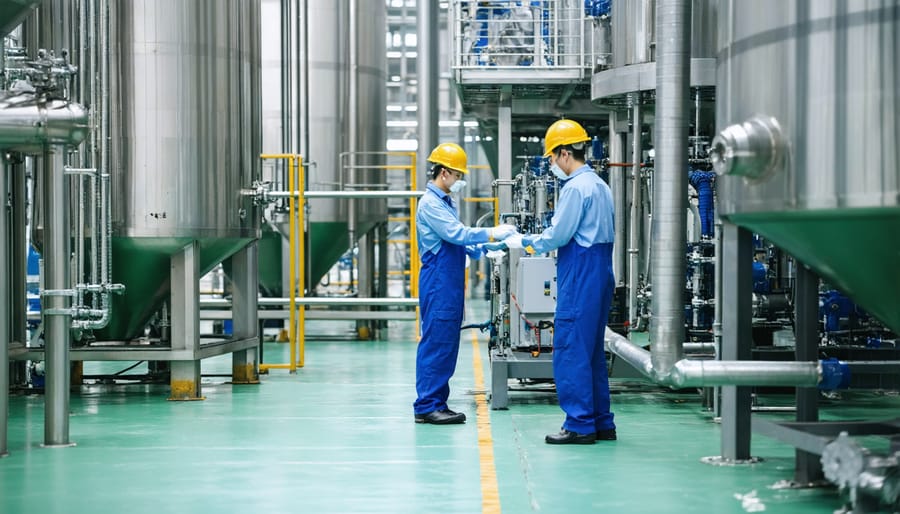Australia’s energy infrastructure stands at a pivotal crossroads, where strategic investments today will shape our sustainable future for decades to come. The growing importance of bioenergy alongside traditional renewable sources has created unprecedented opportunities for investors and industry stakeholders to participate in the nation’s energy transformation.
With an estimated $200 billion in energy infrastructure investments needed by 2040, Australia’s commitment to achieving net-zero emissions has opened new pathways for innovative funding models and public-private partnerships. These investments not only promise attractive returns but also contribute to building resilient, future-proof energy systems that can withstand evolving environmental challenges.
From grid modernization projects to renewable energy storage solutions, the landscape of energy infrastructure investment spans diverse sectors and scales. Forward-thinking investors are particularly drawn to projects that combine technological innovation with sustainable practices, creating a perfect storm of opportunity for those ready to participate in Australia’s energy revolution.
This transformation represents more than just financial prospects – it’s a crucial step toward energy security, environmental stewardship, and economic growth, making energy infrastructure investments one of the most compelling opportunities in today’s market.
The Current State of Bioenergy Infrastructure in Australia
Regional Distribution and Capacity
Australia’s bioenergy landscape showcases a diverse distribution of infrastructure across its states and territories, with each region leveraging its unique resources and capabilities. Queensland leads the pack with its substantial sugarcane industry, converting agricultural waste into power through advanced biomass facilities. Victoria follows closely, utilizing its forestry residues and municipal waste streams effectively.
Western Australia has made significant strides in landfill gas capture and conversion, while South Australia excels in agricultural waste processing. The Northern Territory is emerging as a promising frontier for bioenergy development, particularly in remote communities where hybrid systems combine bioenergy with other renewable sources.
Current capacity varies significantly by region, with metropolitan areas generally hosting larger facilities. Sydney’s Eastern Creek facility processes up to 300,000 tonnes of waste annually, while Brisbane’s waste-to-energy plants handle similar volumes. Regional areas often feature smaller, specialized facilities serving local communities and industries.
The infrastructure distribution reflects both population density and resource availability, with coastal regions typically showing higher concentration of facilities. This pattern aligns with Australia’s settlement patterns and industrial zones, creating efficient energy delivery networks.

Key Players and Stakeholders
Australia’s bioenergy sector is driven by a diverse mix of innovative companies and forward-thinking organisations. Leading the charge is the Clean Energy Finance Corporation (CEFC), which has committed substantial funding to various bioenergy projects nationwide. Their partnerships with local councils and private enterprises have been instrumental in developing waste-to-energy facilities across major cities.
Energy infrastructure giants like AGL and Origin Energy have also made significant moves into the bioenergy space, recognizing its potential as a reliable renewable energy source. Meanwhile, specialized players such as Quantum Power and Phoenix Energy have established themselves as pioneers in agricultural and industrial bioenergy solutions.
Regional farming cooperatives are emerging as crucial stakeholders, providing essential biomass feedstock and participating in local energy generation projects. The Australian Renewable Energy Agency (ARENA) continues to play a pivotal role by providing grants and supporting research initiatives that advance bioenergy technology.
Local governments and waste management authorities have become increasingly active participants, particularly in metropolitan areas where waste-to-energy projects offer dual benefits of waste reduction and energy generation. Indigenous communities are also emerging as important stakeholders, contributing traditional land management practices and participating in regional bioenergy initiatives.
Strategic Investment Opportunities
Agricultural Waste Processing Facilities
Australia’s agricultural sector produces millions of tonnes of organic waste annually, presenting a golden opportunity for smart infrastructure investments in agricultural waste processing facilities. These facilities transform what was once considered mere waste into valuable energy resources, creating a win-win situation for farmers and energy producers alike.
Consider the success story of the Berrybank Farm Piggery in Victoria, which converted its waste management challenge into a profitable energy generation system. By implementing advanced anaerobic digestion technology, the facility now produces enough electricity to power its operations and feeds excess energy back into the grid, while also creating valuable fertilizer as a by-product.
Investment opportunities in this sector are particularly attractive due to their dual economic and environmental benefits. Modern processing facilities can handle various waste streams, from crop residues and animal manure to food processing by-products, making them versatile additions to Australia’s energy infrastructure portfolio.
The return on investment typically comes from multiple revenue streams: energy sales, waste management fees, and the production of organic fertilizers. Government incentives and renewable energy certificates further enhance the financial viability of these projects, making them increasingly attractive to both local and international investors.
For regional communities, these facilities create sustainable jobs while helping agricultural businesses reduce their operational costs and environmental footprint. It’s a practical solution that turns a persistent challenge into a valuable resource, embodying the true spirit of Australian innovation in sustainable agriculture.

Distribution Networks and Storage Solutions
The success of bioenergy projects hinges on robust distribution networks and efficient storage solutions. Across Australia, we’re seeing innovative approaches to addressing these crucial infrastructure needs. Regional hubs are emerging as central points for collecting and processing biomass, creating efficient supply chains that connect farmers, waste management facilities, and energy producers.
Storage facilities are being strategically positioned near agricultural centers and waste processing plants, minimizing transportation costs and reducing carbon footprints. These facilities are equipped with specialized containment systems that maintain optimal moisture levels and prevent degradation of organic materials, ensuring consistent energy production year-round.
In Queensland’s Darling Downs region, a pioneering facility demonstrates the effectiveness of integrated storage solutions. The facility combines traditional silos with modern monitoring systems, allowing operators to manage biomass quality while maintaining steady supply to nearby power plants. Similar successful models are being replicated in Victoria and New South Wales, adapting to local conditions and available feedstock.
Distribution networks are increasingly utilizing existing infrastructure where possible, while developing new, purpose-built systems for areas with high bioenergy potential. Smart logistics platforms are being implemented to optimize collection routes and delivery schedules, ensuring efficient resource allocation and reducing operational costs.
For remote communities, micro-distribution networks are proving particularly effective, creating self-sufficient energy systems that support local economies while reducing dependence on traditional power sources.
Economic and Environmental Returns
Job Creation and Regional Development
Energy infrastructure investments are proving to be powerful catalysts for job creation across Australia, particularly in rural and regional areas. These investments are generating a diverse range of employment opportunities, from construction and engineering roles to ongoing operational and maintenance positions. The development of new energy projects has created significant regional development opportunities that extend far beyond direct employment.
Local communities are experiencing remarkable economic uplift through the establishment of supporting industries and services. For instance, the Western Downs region in Queensland has seen the emergence of new hospitality businesses, accommodation services, and specialized training facilities to support nearby energy projects. These developments create a positive ripple effect throughout local economies, fostering sustainable growth and community resilience.
The skills development aspect is particularly noteworthy, with many projects incorporating training programs and apprenticeships for local residents. This investment in human capital ensures long-term employment prospects while building expertise within regional communities. Indigenous employment programs have also become an integral part of many energy infrastructure projects, promoting inclusive economic growth and cultural engagement.
The multiplier effect of these investments continues to strengthen regional economies, with every direct job creating an estimated 2.5 additional jobs in supporting industries.
Environmental Impact and Carbon Reduction
Energy infrastructure investments in renewable sources are delivering remarkable environmental benefits across Australia. These investments are playing a crucial role in reducing carbon emissions, with new projects already preventing millions of tonnes of CO2 from entering the atmosphere annually. The shift towards cleaner energy infrastructure is particularly impactful in regional areas, where solar farms and wind projects are transforming former coal-dependent communities into renewable energy hubs.
The environmental impact extends beyond carbon reduction. Modern energy facilities are designed with biodiversity protection in mind, often incorporating wildlife corridors and native vegetation programs. For instance, several solar farms in Queensland have successfully integrated sheep grazing between panels, demonstrating how renewable energy can coexist with traditional land use.
These investments are helping Australia progress towards its commitment to net-zero emissions by 2050. Current projections show that renewable energy infrastructure projects could reduce national carbon emissions by up to 30% by 2030, compared to 2005 levels. This progress is particularly significant in the industrial sector, where energy-efficient infrastructure is revolutionizing manufacturing processes.
Water conservation is another environmental benefit, as renewable energy facilities typically require significantly less water than traditional power plants. This aspect is especially valuable in Australia’s drought-prone regions, where water scarcity is a pressing concern.

Success Stories and Case Studies
Australia’s transition to renewable energy is marked by numerous successful bioenergy infrastructure projects that demonstrate the viability and potential of this sustainable energy source. One standout example is the Richgro Bioenergy Plant in Western Australia, which transformed from a traditional composting facility into a state-of-the-art bioenergy powerhouse. By converting organic waste into electricity and biofertilizer, the facility now generates enough power for its entire operation while reducing annual carbon emissions by 142,722 tonnes.
The Mount Piper Power Station’s biomass co-firing initiative in New South Wales showcases how traditional energy infrastructure can be adapted for renewable purposes. The facility now processes up to 80,000 tonnes of woody biomass annually, creating local jobs while reducing its carbon footprint by 20%. This project has become a blueprint for other coal-fired power stations looking to transition to cleaner energy solutions.
Queensland’s MSF Sugar’s Tableland Mill presents another inspiring case study. The facility generates 24 MW of renewable electricity from bagasse, a sugarcane byproduct, powering both the mill and feeding surplus energy into the local grid. This project exemplifies the circular economy in action, turning agricultural waste into valuable energy resources.
The Beaufort Hospital Bioenergy Project in Victoria demonstrates the potential for smaller-scale implementations. By switching from natural gas to wood waste biomass for heating, the hospital reduced its energy costs by 40% and sparked similar initiatives across regional healthcare facilities.
In South Australia, the Northern Adelaide Waste Management Authority’s (NAWMA) Food Waste to Energy Plant represents innovation in urban waste management. The facility processes 22,000 tonnes of food waste annually, generating enough power for 2,500 homes while diverting waste from landfills.
These success stories highlight the diverse applications of bioenergy across different scales and sectors. They demonstrate not only the environmental benefits but also the economic advantages of investing in renewable energy infrastructure. Each project serves as a practical example of how bioenergy can contribute to Australia’s renewable energy targets while creating sustainable business opportunities and local employment.
As Australia continues to forge ahead in its renewable energy journey, investing in bioenergy infrastructure represents more than just a financial opportunity – it’s a crucial step toward a sustainable future. The success stories we’ve witnessed across the country, from regional waste-to-energy facilities to large-scale biomass projects, demonstrate the immense potential of this sector.
Looking ahead, the outlook for bioenergy infrastructure investment remains overwhelmingly positive. With increasing government support, technological advancements, and growing environmental awareness, the sector is poised for significant expansion. The next decade will likely see more innovative projects emerge, creating new jobs, supporting regional communities, and contributing to Australia’s renewable energy targets.
For investors, industry professionals, and policymakers, the message is clear: bioenergy infrastructure represents a reliable, sustainable, and profitable pathway to energy security. By continuing to support and develop these initiatives, we’re not just building energy facilities – we’re creating a legacy of clean, renewable power for future generations. The time to act is now, as we work together to transform Australia’s energy landscape and lead the way in sustainable infrastructure development.

